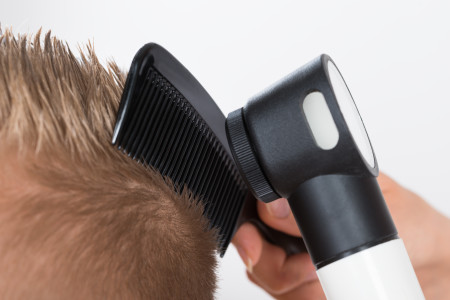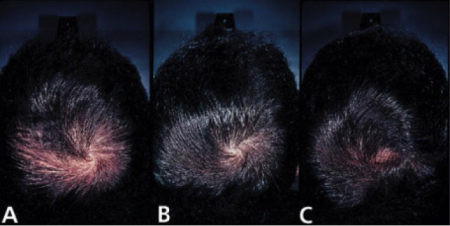Hair loss: Diagnosis and treatment
Dermatologists have expertise in diagnosing hair loss and counseling their patients on what may help them regrow their hair
This dermatologist is using a dermatoscope to examine a patient’s scalp.

Effective treatment for hair loss begins with finding the cause. To get an accurate diagnosis, it helps to see a board-certified dermatologist. These doctors have in-depth knowledge about the many causes of hair loss and experience treating the diverse causes.
How do dermatologists find out what’s causing hair loss?
To pinpoint the cause of your hair loss, a dermatologist begins by gathering information. Your dermatologist will:
Ask questions. It’s important to know how long you’ve had hair loss and whether it came on quickly.
Look closely at your scalp, nails, any other area with hair loss. This exam provides vital clues about what’s happening.
Test the health of your hair. Gently pulling on your hair tells your dermatologist a lot about how your hair is growing and whether it’s prone to breaking.
If your dermatologist suspects that the cause of your hair loss could be a disease, vitamin deficiency, hormone imbalance, or infection, you may need a blood test or scalp biopsy. These tests can be done in your dermatologist’s office.
Once your dermatologist has this information, it’s often possible to tell you what’s causing your hair loss.
Sometimes, your dermatologist needs more information. This might be the case if someone has more than one cause. For example, a woman may have had a baby a few months ago, and this may be causing obvious hair shedding. She may also have early hereditary loss, which isn’t so obvious.
No one hair loss treatment works for everyone
Once your dermatologist finds the cause(s), your dermatologist will tell you whether treatment is recommended. Sometimes, your hair will regrow on its own, making treatment unnecessary.

When hair may regrow on its own
Yes, your hair may regrow on its own. This can happen if you recently:
Had a baby
Recovered from a major illness or had surgery
Underwent cancer treatment
Lost 20 pounds or more
Developed a mild case of a disease called alopecia areata, which causes your immune system to attack your hair follicles
Got rid of psoriasis on your scalp
Your dermatologist can tell you whether your hair may start to grow again on its own.
Sometimes to see regrowth, you need to make some changes.
Changing your hair care (or hairstyle) may help
Some hairstyles and hair care habits can damage hair, leading to hair loss. If your dermatologist finds that this may be causing your hair loss, your dermatologist can recommend changes that will help you stop damaging your hair.
You’ll find tips that dermatologists give their patients at:
When do dermatologists recommend treatment for hair loss?
While your hair may regrow on its own, your dermatologist may recommend treatment to help it grow more quickly. Sometimes, treatment is essential to prevent further hair loss.
A treatment plan for hair loss may include one or more of the following.
At-home treatments for hair loss
At-home treatments offer convenience, and you can buy many of them without a prescription. Because studies show that the following can help, your dermatologist may include one (or more) in your at-home treatment plan.
Minoxidil (Rogaine®): Minoxidil can help early hair loss; it cannot regrow an entire head of hair.
To use minoxidil, you apply it to the scalp as directed, usually once or twice a day.
When used as directed, minoxidil can:
Stimulate hair growth
Prevent further hair loss
Minoxidil tends to be more effective when used along with another treatment for hair loss. Many people see some regrowth when using minoxidil, but it takes time to see results, usually about 6 to 12 months.
Should you see regrowth, you will need to keep using it every day.
If you stop applying minoxidil, you lose its benefits. Because minoxidil helps you maintain your hair’s thickness, some hairs may look and feel thinner. You’ll also gradually notice that you’re shedding more hair.
Laser for at-home use: You can buy laser caps and combs to treat hair loss at home. While only a few studies have looked at these devices, the results are promising.
In one study, more than 200 men and women who had hereditary hair loss were given either a laser hair comb or a sham device that looked like a laser comb. The patients used the device that they were given 3 times per week for 26 weeks.
The researchers found that some patients using the laser rather than the sham device saw overall thicker and fuller hair.
It’s important to understand that not everyone who used a laser saw regrowth.
More studies are needed to find out who is most likely to benefit from this treatment and whether these devices cause long-term side effects.
Microneedling: A microneedling device contains hundreds of tiny needles. A few studies have shown that it can help stimulate hair growth. In one study, men between the ages of 20 and 35 years old who had mild or moderate hereditary hair loss were treated with either:
5% minoxidil twice a day
5% minoxidil twice a day plus weekly microneedling
After 12 weeks of treatment, the patients treated with minoxidil and microneedling had significantly more hair growth.
Other studies have shown that using microneedling along with another treatment, including platelet-rich plasma or a corticosteroid that you apply to the thinning area, helps improve hair growth.
While you can buy a microneedling device without a prescription, it’s best to check with your dermatologist first. Microneedling can worsen some conditions. It’s also important to get the right microneedling device.
The devices used for hair loss contain longer needles than the those used to treat the skin.
Procedures to help regrow hair
While at-home treatments offer convenience, a procedure performed by a board-certified dermatologist tends to be more effective. For this reason, your dermatologist may include one of the following in your treatment plan.
Injections of corticosteroids: To help your hair regrow, your dermatologist injects this medication into the bald (or thinning) areas. These injections are usually given every 4 to 8 weeks as needed, so you will need to return to your dermatologist’s office for treatment.
This is considered the most effective treatment for people who have a few patches of alopecia areata, a condition that causes hair loss. In one study of 127 patients with patchy alopecia areata, more than 80% who were treated with these injections had at least half of their hair regrow within 12 weeks.
Hair transplant: If you have an area of thinning or balding due to male (or female) pattern baldness, your dermatologist may mention a hair transplant as an option. This can be an effective and permanent solution.
To learn more, go to: A hair transplant can give you permanent, natural-looking results.
Laser therapy: If using minoxidil every day or taking medication to treat hair loss seems unappealing to you, laser therapy may be an option. Also called low-level laser therapy, a few studies suggest that this may help:
Hereditary hair loss
Alopecia areata
Hair loss due to chemotherapy
Stimulate healing and hair growth after a hair transplant
Studies indicate that laser therapy is safe and painless but requires many treatment sessions. To see a bit of hair growth, you may need several treatments a week for many months.
Platelet-rich plasma (PRP): Studies show that this can be a safe and effective hair loss treatment. PRP involves drawing a small amount of your blood, placing your blood into a machine that separates it into parts, and then injecting one part of your blood (the plasma) into the area with hair loss.
The entire procedure takes about 10 minutes and usually doesn’t require any downtime.
You will need to return for repeat injections. Most patients return once a month for 3 months and then once every 3 to 6 months.
Within the first few months of treatment, you may notice that you are losing less or minimal amounts of hair.
Prescription medication that can regrow hair
Another treatment option is to take prescription medication. The type of medication prescribed will depend on your:
Hair loss cause
Overall health
Age
Expected results
Plans for getting pregnant
With any medication, side effects are possible. Ask your dermatologist about possible side effects that you might experience while taking one of these medications to treat hair loss. The medications include:
Finasteride (Propecia®): The U.S. Food and Drug Administration (FDA) approved this medication to treat male pattern hair loss. When taken as directed, finasteride can:
Slow down hair loss
Stimulate new hair growth
Finasteride is a pill that you take once a day. Taking it at the same time each day seems to produce the best results.
Finasteride: Before and after
This man took finasteride to treat his male pattern hair loss, and within 1 year (B), he had noticeable improvement. After 2 years (C), he had regrown most of his hair.

Like other treatments for hair loss, this, too, takes time to work. It usually takes about 4 months to notice any improvement.
Finasteride tends to be more effective if you begin taking it when you first notice hair loss. A dermatologist may also prescribe this medication to treat a woman who has hereditary hair loss and cannot get pregnant.
If finasteride works for you, you will need to keep taking it to continue getting results. Once you stop, you’ll start losing hair again. Before taking this medication, be sure to discuss possible side effects with your dermatologist.
Spironolactone: For women who have female pattern hair loss, this medication may be an option. It can:
Stop further hair loss
Increase hair thickness
Studies indicate that this medication is effective in about 40% for women who have female pattern hair loss. In one study of 166 women taking spironolactone, 42% said they had mild improvement, and 31% reported increased thickness.
It’s essential that you not become pregnant while taking spironolactone. This medication can cause birth defects. To prevent pregnancy, your dermatologist will also prescribe a birth control pill if it’s possible for you to get pregnant.
Other medications: If you have an infection or painful inflammation, your dermatologist can prescribe medication to treat these.
For example, if you have a type of hair loss called frontal fibrosing alopecia (FFA), which can cause painful inflammation, your dermatologist may prescribe an antibiotic and antimalarial medication. Scalp ringworm, which is caused by a fungus, requires antifungal medication.
Vitamins, minerals, and other supplements
If your blood test reveals that you’re not getting enough biotin, iron, or zinc, your dermatologist may recommend taking a supplement. If you’re not getting enough protein, your dermatologist can tell you how to boost your intake.
You should only take biotin, iron, or zinc when your blood test shows that you have a deficiency. If your levels are normal, taking a supplement can be harmful. For example, if you take too much iron, you can develop iron poisoning. Early signs of this include stomach pain and vomiting.
Other supplements meant to help with hair loss tend to contain a lot of one nutrient. Because this can cause you to get too much of the nutrient, many dermatologists recommend taking a multivitamin instead.
Wigs and concealers
Do you feel uncomfortable taking medication? Does your schedule limit the amount of time you have for treatment? Is the cost of treatment, which insurance generally will not cover, too expensive?
If you answered yes to any of these questions, your dermatologist may recommend a wig or concealer.
While these cannot slow hair loss or help you regrow hair, they can boost your self-esteem. Another advantage is that a wig or concealer offers immediate results.
Many types of wigs, including ones that can be custom-made for you, are available. If you’re looking for a concealer, such as a spray or powder that can hide hair loss, you’ll find many products available online. With endless choices, it can be helpful to have a dermatologist guide you in selecting one.
What is the outcome for someone who has hair loss?
With an accurate diagnosis, many people who have hair loss can see hair regrowth. If you need treatment for regrowth, the earlier you start, the more likely you are to see regrowth.
It’s important to understand that:
Not every type of hair loss can be treated, but a dermatologist may be able to prevent further hair loss.
It can take months before you see results from treatment.
No one treatment works for everyone, even two people with the same type of hair loss.
Sometimes, hair loss is stubborn and requires trying different treatments before finding one that works.
Self-care also plays an essential role in preventing and treating hair loss. To find out what dermatologists recommend, go to Hair loss: Self-care.
Images
Images 1 and 2: Getty Images
Image 3: Property of the American Academy of Dermatology, A to Z Video Series
Image 4: Image used with permission of Journal of the American Academy of Dermatology: J Am Acad Dermatol. 1998; 39:578-89.
References
Adil A, Godwin M. “The effectiveness of treatments for androgenetic alopecia: A systematic review and meta-analysis.” J Am Acad Dermatol. 2017;77:136-141.
American Academy of Dermatology:
“Research demonstrates potential of platelet-rich plasma therapy for hair loss” News release issued March 1, 2019. Last accessed May 22, 2019.
New generation of laser and light therapies could provide future treatment options for skin, hair and nail conditions,” News release issued March 16, 2012. Last accessed May 22, 2019.
Avci P, Gupta GK, et al. “Low-level laser (light) therapy (LLLT) for treatment of hair loss.” Lasers Surg Med. 2014;46:144-51.
Dhurat R, Sukesh M, et al. “A randomized evaluator blinded study of effect of microneedling in androgenetic alopecia: A pilot study.” Int J Trichology. 2013;5:6-11.
Donovan J. (2019, March) “Medically maximizing male and female hair loss.” In: Rogers NE (Director) Session S032: Alopecia: Work-up and treatment.” Symposium conducted at the 2019 Annual Meeting of the American Academy of Dermatology, Washington, DC.
Freites-Martinez A, Shapiro J, et al. “Hair disorders in cancer survivors.” J Am Acad Dermatol. 2019;80:1199-1213.
Goren A, Shapiro J, et al. “Clinical utility and validity of minoxidil response testing in androgenetic alopecia.” Dermatol Ther. 2015;28:13-6.
Jimenez JJ, Wikramanayake TC, et al. “Efficacy and safety of a low-level laser device in the treatment of male and female pattern hair loss: a multicenter, randomized, sham device-controlled, double-blind study.” Am J Clin Dermatol. 2014;15:115-27.
Kumar MK, Inamadar AC, et al. “A randomized controlled, single-observer blinded study to determine the efficacy of topical minoxidil plus microneedling versus topical minoxidil alone in the treatment of androgenetic alopecia.” J Cutan Aesthet Surg. 2018;11:211-6.
Paus R, Olsen EA, et al. “Hair growth disorders.” In: Wolff K, Goldsmith LA, et al. Fitzpatrick’s Dermatology in General Medicine (seventh edition). McGraw Hill Medical, New York, 2008:753-74.
Ring CM, Keller MS. “Research letters: Effect of camouflaging agents on psychologic well-being: A cross-sectional survey of hair loss patients.” J Am Acad Dermatol. 2017;76:1186-9. Funding sources: None. Conflicts of interest: None declared
Rodrigues BL, Montalvão SAL, et al. “Treatment of male pattern alopecia with platelet-rich plasma: A double-blind controlled study with analysis of platelet number and growth factor levels.” J Am Acad Dermatol. 2019;80:694-700.
Shannon F, Christa S, et. al. “Demographics of women with female pattern hair loss and the effectiveness of spironolactone therapy.” J Am Acad Dermatol. 2015;73: 705-6.
Last updated: 12/13/22
 Atopic dermatitis: More FDA-approved treatments
Atopic dermatitis: More FDA-approved treatments
 Biosimilars: 14 FAQs
Biosimilars: 14 FAQs
 How to trim your nails
How to trim your nails
 Relieve uncontrollably itchy skin
Relieve uncontrollably itchy skin
 Fade dark spots
Fade dark spots
 Untreatable razor bumps or acne?
Untreatable razor bumps or acne?
 Tattoo removal
Tattoo removal
 Scar treatment
Scar treatment
 Free materials to help raise skin cancer awareness
Free materials to help raise skin cancer awareness
 Dermatologist-approved lesson plans, activities you can use
Dermatologist-approved lesson plans, activities you can use
 Find a Dermatologist
Find a Dermatologist
 What is a dermatologist?
What is a dermatologist?